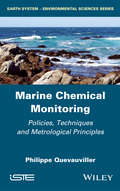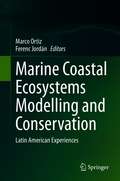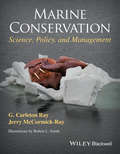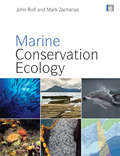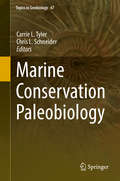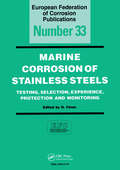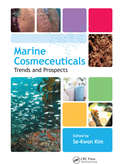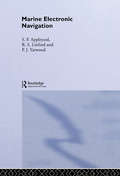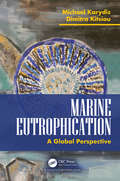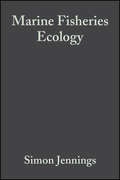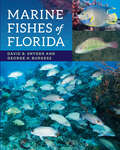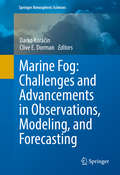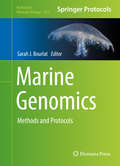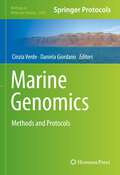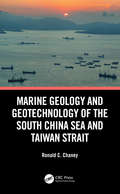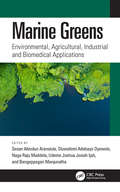- Table View
- List View
Marine Chemical Monitoring: Policies, Techniques and Metrological Principles (Water Quality Measurements Ser. #29)
by Philippe QuevauvillerCombining laboratory experience with research and policy developments, this book provides an insight into the historical background of marine monitoring, its regulatory frameworks and science–policy interactions. With experience in the European Commission, the author draws from practical experience in research and policy implementation to present a concise review of marine monitoring on an international level. The author deals with monitoring and related QA/QC principles, focusing on monitoring types, while describing general features of analytical methods used in marine monitoring. The book concludes with a discussion about how to achieve metrology principles (measurement traceability) in marine monitoring.
Marine Coastal Ecosystems Modelling and Conservation: Latin American Experiences
by Marco Ortiz Ferenc JordánThe book presents a collection of large-scale network-modeling studies on coastal systems in Latin America. It includes a novel description of the functioning of coastal complex ecosystems and also predicts how natural and human-made disturbances percolate through the networks. Coastal areas belong to the most populated ecosystems around the globe, and are massively influenced by human impacts such as shipping, mining, fisheries, tourism, pollution and human settlements. Even though many of these activities have facilitated socio-economic development, they have also caused a significant deterioration in natural populations, communities and ecosystems worldwide. Covering coastal marine ecosystems of Latin America such as the NE and SE Pacific, NW Atlantic and Caribbean areas, it discusses the construction of quantitative (Ecopath-Ecosim-Ecospace and Centrality of Node Sets) and semi-quantitative (Loop Analysis) multispecies trophic-network models to describe and assess the impacts of natural and human interventions like pelagic and benthic fishing as well as natural events such as El Niño, and La Niña. The book also features steady state (and/or near moving equilibrium) and dynamical models to support the management of exploited organisms, and applies and quantifies macroscopic indices, based on Ascendency (Ulanowicz) and Local Stability (Levins´ Loop Analysis). Further, it discusses the determination of the Keystone Species Complex Index, which is a holistic extension of the classical concept of Keystone Species (Paine), offering novel strategies for conservation monitoring and management.
Marine Conservation
by G. Carleton Ray Jerry Mccormick-Ray Robert L. Smith Jr.Providing a guide for marine conservation practice, Marine Conservation takes a whole-systems approach, covering major advances in marine ecosystem understanding. Its premise is that conservation must be informed by the natural histories of organisms together with the hierarchy of scale-related linkages and ecosystem processes. The authors introduce a broad range of overlapping issues and the conservation mechanisms that have been devised to achieve marine conservation goals. The book provides students and conservation practitioners with a framework for thoughtful, critical thinking in order to incite innovation in the 21st century."Marine Conservation presents a scholarly but eminently readable case for the necessity of a systems approach to conserving the oceans, combining superb introductions to the science, law and policy frameworks with carefully chosen case studies. This superb volume is a must for anyone interested in marine conservation, from students and practitioners to lay readers and policy-makers."--Simon Levin, George M. Moffett Professor of Biology, Department of Ecology & Evolutionary Biology, Princeton University
Marine Conservation Ecology
by John RoffThis major textbook provides a broad coverage of the ecological foundations of marine conservation, including the rationale, importance and practicalities of various approaches to marine conservation and management. The scope of the book encompasses an understanding of the elements of marine biodiversity - from global to local levels - threats to marine biodiversity, and the structure and function of marine environments as related to conservation issues. The authors describe the potential approaches, initiatives and various options for conservation, from the genetic to the species, community and ecosystem levels in marine environments. They explore methods for identifying the units of conservation, and the development of defensible frameworks for marine conservation. They describe planning of ecologically integrated conservation strategies, including decision-making on size, boundaries, numbers and connectivity of protected area networks. The book also addresses relationships between fisheries and biodiversity, novel methods for conservation planning in the coastal zone and the evaluation of conservation initiatives.
Marine Conservation Paleobiology (Topics in Geobiology #47)
by Carrie L. Tyler Chris L. SchneiderThis volume describes and explores the emerging discipline of conservation paleobiology, and addresses challenges faced by established and young Conservation Paleobiologist's alike. In addition, this volume includes applied research highlighting how conservation paleobiology can be used to understand ecosystem response to perturbation in near and deep time. Across 10 chapters, the book aims to (1) explore the goals of conservation paleoecology as a science, (2) highlight how conservation paleoecology can be used to understand ecosystems’ responses to crises, (3) provide case studies of applications to modern ecosystems, (4) develop novel applications of paleontological approaches to neontological data, and (5) present a range of ecosystem response and recovery through environmental crises, from high-resolution impacts on organism interactions to the broadest scale of responses of the entire marine biosphere to global change. The volume will be of interest to paleoecologists, paleobiologists, and conservation biologists.
Marine Corrosion of Stainless Steels: Testing, Selection, Experience, Protection and Monitoring (European Federation of Corrosion Publications)
by D. FéronThis is Number 33 of the Marine Corrosion of Stainless Steels, a publication of the European Federation of Corrosion (EFC). Part I of this volume on the "Marine Corrosion of Stainless Steels" consists of five chapters and is concerned with tests that were conducted in the 1990s on the corrosivity of European sea waters (Atlantic, Baltic, English Channel, Mediterranean, and North Sea) towards three types of stainless steels. Results from these two test programmes were presented at a European Workshop on Sea Water Corrosion of Stainless Steels in Trondheim in 1996 and at various corrosion conferences, mostly in Europe. The other four chapters in Part I describe experimental procedures, critical pitting temperature data, crevice corrosion results and results from the MAST biofilm studies. The remaining 23 chapters of the book are concerned with reviews and reports that develop the above topics.
Marine Cosmeceuticals: Trends and Prospects
by Se-Kwon KimMarine Cosmeceuticals: Trends and Prospects is a consolidated overview of the marine environment as a productive source of novel cosmeceuticals. It accumulates the latest research in this field from around the globe, highlighting the potential of marine micro and macro flora and fauna as effective agents for the development of novel cosmeceuticals.
Marine Distributions (The Royal Society of Canada Special Publications #5)
by Maxwell DunbarA symposium of the Royal Society of Canada was held in June 1962 to outline what is being done in Canadian oceanography to map salinity, temperature, and plankton in the waters around Canada and in the North Atlantic across to Europe. This volume, based on the symposium, emphasizes the interdisciplinary nature of research in marine biogeography and in the distribution of environmental factors in the sea. The book is intended to show the breadth of biogeographic work in the sea, and the relation between biogeography and the physics and chemistry of the marine environment. It serves also to introduce to the scientific public the new Serial Atlas of the Marine Environment, a scientific journal of a new kind of sponsored jointly by the Royal Society of Canada and the U.S. National Academy of Sciences.
Marine Ecological Processes
by Ivan ValielaThe oceans represent a vast, complex and poorly understood ecosystem. Marine Ecological Processes is a modern review and synthesis of marine ecology that provides the reader with a lucid introduction to the intellectual concepts, approaches, and methods of this evolving discipline. Comprehensive in its coverage, this book focuses on the processes controlling marine ecosystems, communities, and populations and demonstrates how general ecological principles--derived from terrestrial and freshwater systems as well--apply to marine ecosystems. Global warming and increased eutrophication and wetland destruction in recent years has made the study of ecological processes even more important for the preservation of marine environments. This thoroughly updated and expanded edition will provide students of marine ecology, marine biology, and oceanography with numerous illustrations, examples, and references which clearly impart to the reader the current state of research in this field: its achievements as well as unresolved controversies.
Marine Electronic Navigation
by Stephen F. Appleyard"This 600 page textbook must be a good candidate for being the authoritative reference on its subject....This book reveals all through a good, clear text amply illustrated... The authors and publisher are to be congratulated on an excellent production."--The Naval Review Well organized, clear and easy to read. The second edition has been enlarged with various items devoted to new electronic equipment now encountered by mariners, especially those concerned with navigational and radiocommunication equipment."--International Hydrographic Bulletin "A major and standard text, now much enlarged and revised with sections on radar, communications, the gyro compass and all navigation systems encountered in merchant ships. Full and expert treatment of all aspects of electronic navigation and communication systems making it one of the leading references on its subjects."--Lloyds List
Marine Eutrophication: A Global Perspective
by Michael Karydis Dimitra KitsiouMarine eutrophication has been recognized as a global problem with adverse effects on ecosystem’s health and the economies of coastal states. Most conventions regarding marine environmental protection of Regional Seas have given priority to eutrophication and relevant management practices. This book presents a global perspective of eutrophication in most of the Regional Seas, including the legal framework, assessment and management practices. Information on ecosystem’s impact as well as an outline of the methods used for assessing eutrophication is also provided. This volume will be useful to research students, marine scientists and policy makers working in marine environmental management. Key Features: Contributes to the understanding of the eutrophication processes and problems Presents an extensive account of the data analysis methods used for the quantitative assessment of eutrophication Looks the eutrophication status of the main regional seas Provides information on eutrophication politics and measures to mitigate eutrophication
Marine Fisheries Ecology
by Simon Jennings Michel Kaiser John D. ReynoldsThis topical and exciting textbook describes fisheries exploitation, biology, conservation and management, and reflects many recent and important changes in fisheries science. These include growing concerns about the environmental impacts of fisheries, the role of ecological interactions in determining population dynamics, and the incorporation of uncertainty and precautionary principles into management advice. The book draws upon examples from tropical, temperate and polar environments, and provides readers with a broad understanding of the biological, economic and social aspects of fisheries ecology and the interplay between them. As well as covering 'classical' fisheries science, the book focuses on contemporary issues such as industrial fishing, poverty and conflict in fishing communities, marine reserves, the effects of fishing on coral reefs and by-catches of mammals, seabirds and reptiles. The book is primarily written for students of fisheries science and marine ecology, but should also appeal to practicing fisheries scientists and those interested in conservation and the impacts of humans on the marine environment. particularly useful are the modelling chapters which explain the difficult maths involved in a user-friendly manner describes fisheries exploitation, conservation and management in tropical, temperate and polar environments broad coverage of 'clasical' fisheries science emphasis on new approaches to fisheries science and the ecosystem effects of fishing examples based on the latest research and drawn from authors' international experience comprehensively referenced throughout extensively illustrated with photographs and line drawings
Marine Fishes of Florida
by George H. Burgess David B. SnyderThe essential illustrated guide to Florida’s marine fishes.The most comprehensive book about Florida's marine fishes ever produced, Marine Fishes of Florida includes hundreds of photographs and descriptions of species you'll encounter—plus many that are rare—when diving, snorkeling, kayaking, or fishing. Coverage includes both the Atlantic and Gulf coastline, from habitats near the shore to deeper waters. Fishes found in coastal rivers and other brackish waters are fully represented, as are offshore species that venture into Florida's waters often enough to be called "occasional visitors." David B. Snyder and George H. Burgess intertwine personal observations with results from research studies to provide accurate—often surprising—details. The result is a set of beautifully succinct identification descriptions coupled with information about each species' natural history. From the largest sharks to the smallest cryptic gobies, from homely toadfishes to the spectacularly colored reef fishes, this book is certain to help you better understand the fish you've seen or hooked.Features of Marine Fishes of Florida include Color photographs by leading marine photographers Differentiation of adult and juvenile forms Coverage of 133 fish families and hundreds of species Size and geographical range data Natural history and conservation notes Explanations of geologic history and current habitats
Marine Fishes of Florida
by George H. Burgess David B. Snyder&“A highly useful and interesting reference for ichthyologists, recreational fish enthusiasts and those working in Florida waters . . . a worthy addition.&” —Marine Biology Research The most comprehensive book about Florida&’s marine fishes ever produced, Marine Fishes of Florida includes hundreds of photographs and descriptions of species you&’ll encounter—plus many that are rare—when diving, snorkeling, kayaking, or fishing. Coverage includes both the Atlantic and Gulf coastline, from habitats near the shore to deeper waters. Fishes found in coastal rivers and other brackish waters are fully represented, as are offshore species that venture into Florida&’s waters often enough to be called &“occasional visitors.&” David B. Snyder and George H. Burgess intertwine personal observations with results from research studies to provide accurate—often surprising—details. The result is a set of beautifully succinct identification descriptions coupled with information about each species&’ natural history. From the largest sharks to the smallest cryptic gobies, from homely toadfishes to the spectacularly colored reef fishes, this book is certain to help you better understand the fish you&’ve seen or hooked. Features of Marine Fishes of Florida include: Color photographs by leading marine photographersDifferentiation of adult and juvenile formsCoverage of 133 fish families and hundreds of speciesSize and geographical range dataNatural history and conservation notesExplanations of geologic history and current habitats&“Entertaining and informative . . . I think this book will be a great addition to the library of any biologist, fisher, diver or student, and I strongly recommend this book to anyone wishing to expand their knowledge of Florida fishes.&” —Environmental Biology of Fishes
Marine Fog: Challenges and Advancements in Observations, Modeling, and Forecasting (Springer Atmospheric Sciences)
by Darko Koračin Clive E. DormanThis volume presents the history of marine fog research and applications, and discusses the physical processes leading to fog's formation, evolution, and dissipation. A special emphasis is on the challenges and advancements of fog observation and modeling as well as on efforts toward operational fog forecasting and linkages and feedbacks between marine fog and the environment.
Marine Genomics
by Sarah J. BourlatThis volume presents the latest protocols for both laboratory and bioinformatics based analyses in the field of marine genomics. The chapters presented in the book cover a wide range of topics, including the sampling and genomics of bacterial communities, DNA extraction in marine organisms, high-throughput sequencing of whole mitochondrial genomes, phylogenomics, SNP discovery, SNP-arrays for species identification, digital PCR-based quantification methods, environment DNA for invasive species surveillance and monitoring, microarrays for the detection of waterborne pathogens, DNA barcoding of marine biodiversity, metabarcoding protocols for marine eukaryotes, analytical protocols for the visualization of eukaryotic diversity, and applications for genomic data to benthic indices for environmental monitoring. Written in the highly successful "Methods in Molecular Biology" series format, chapters include introduction to their respective topics, lists of the necessary materials and reagents, step-by-step, readily reproducible laboratory protocols, and tips on troubleshooting and avoiding known pitfalls. Cutting-edge and thorough, "Marine Genomics: Methods and Protocols" is a valuable resource for researchers, students, and policy makers in the field of marine biology.
Marine Genomics: Methods and Protocols (Methods in Molecular Biology #2498)
by Cinzia Verde Daniela GiordanoThis detailed volume provides an overview of recent advances in the application of genomic technologies in several domains of marine biology, raising awareness of various DNA- and RNA-based technologies. Genomic methods are essential in identifying previously undetected taxonomic (e.g. DNA barcoding), genetic (e.g. sequencing), and functional (e.g. gene expression, analysis of metabolites) diversity, as shown in the chapters of this book, with sections focusing on next generation sequencing (NGS) technologies, bioinformatics in marine genomics research, marine biotechnology, as well as a variety of methods successfully applied in fish. Written for the highly successful Methods in Molecular Biology series, chapters include introductions to their respective topics, lists of the necessary materials and reagents, step-by-step, readily reproducible laboratory protocols, and tips on troubleshooting and avoiding known pitfalls. Authoritative and practical, Marine Genomics: Methods and Protocols highlights the utility of numerous lab protocols and their potential to provide deeper insight into physiological and ecological mechanisms in marine life.
Marine Geology and Geotechnology of the South China Sea and Taiwan Strait
by Ronald C. ChaneyThe waters and rich resources of the South China Sea are claimed by seven different countries, and it is estimated that approximately 40% of the world’s trade moves through the area. Marine Geology and Geotechnology of the South China Sea and Taiwan Strait examines the physiology, geology, and potential development of this important portion of the western Pacific Ocean’s largest marginal sea. The book covers multiple oceanographic topics, and further discusses topography, sedimentation, wave generation, and hazards such as earthquakes, storm surges, and tsunamis. In addition, it explains the engineering issues and design considerations involved regarding a potential Taiwan Strait Crossing, as well as the development of near-shore communities. Features: Examines seabed material, such as clays, calcareous, siliceous, and various other organic sediments Presents different potential routing strategies for sea crossings using tunnels, bridges, or a combination of both Provides bridge design recommendations considering aesthetics, seismic and wind issues, potential vessel collisions, and more Includes a historical timeline and useful maps regarding the political complexity of the area and the various territorial claims made by different nations Marine Geology and Geotechnology of the South China Sea and Taiwan Strait serves as a valuable resource for geotechnical engineers, marine geologists, civil engineers, and professionals concerned with the region.
Marine Glycobiology: Principles and Applications
by Se-Kwon KimMarine glycobiology is an emerging and exciting area in the field of science and medicine. Glycobiology, the study of the structure and function of carbohydrates and carbohydrate-containing molecules, is fundamental to all biological systems and represents a developing field of science that has made huge advances in the last half-century. This book revolutionizes the concept of marine glycobiology, focusing on the latest principles and applications of marine glycobiology and their relationships.
Marine Greens: Environmental, Agricultural, Industrial and Biomedical Applications
by Sesan Abiodun Aransiola, Oluwafemi Adebayo Oyewole, Naga Raju Maddela, Udeme Joshua Josiah Ijah, and Bangeppagari ManjunathaThis book provides an in-depth overview of marine greens and their environmental and biotechnological applications. It addresses concepts such as the niche adaptation strategies of marine greens in their natural habitats, as well as their global distribution, and factors affecting their distribution and proliferation.Marine greens are posited as an alternative to fossil fuels, mitigating global climate change and thereby fostering future environmental sustainability. In addition, the book explains the remediation of xenobiotics, wastewater, microplastics, marine debris and marine green contamination. Expert authors from around the world explore the industrial and agricultural applications of marine greens in the production of enzymes and marine bioenergy, and what is needed to improve its production potential.This is important reading for government and non-governmental organizations as well as industries and research institutions looking for ways to combat current industrial and environmental challenges.
Marine Hard Bottom Communities
by Martin WahlMarine hard bottoms feature some of the most spectacular and diverse biological communities on this planet. These not only contain a rich treasure of genetic, taxonomic and functional information but also deliver irreplaceable ecosystem services. At the same time, they are highly vulnerable and increasingly threatened by anthropogenic pressures. This volume has collected contributions by 50 scientists from numerous biogeographic regions, dealing with characteristics of hard bottom communities. Distributional patterns in space and time are described, followed by analyses of the intrinsic and extrinsic dynamics producing these patterns. A strong emphasis is placed on the ongoing changes occurring in the structure and diversity of these communities in response to spiralling environmental impacts, and on state-of-the-art countermeasures aiming to preserve these ecological treasures. Finally, various values of diversity are assessed, hopefully as an incentive for enhanced conservation efforts.
Marine Historical Ecology in Conservation: Applying the Past to Manage for the Future
by John N. Kittinger Loren Mcclenachan Keryn B. Gedan Louise K. BlightThis pioneering volume provides a blueprint for managing the challenges of ocean conservation using marine historical ecology--an interdisciplinary area of study that is helping society to gain a more in-depth understanding of past human-environmental interactions in coastal and marine ecosystems and of the ecological and social outcomes associated with these interactions. Developed by groundbreaking practitioners in the field, Marine Historical Ecology in Conservation highlights the innovative ways that historical ecology can be applied to improve conservation and management efforts in the oceans. The book focuses on four key challenges that confront marine conservation: (1) recovering endangered species, (2) conserving fisheries, (3) restoring ecosystems, and (4) engaging the public. Chapters emphasize real-world conservation scenarios appropriate for students, faculty, researchers, and practitioners in marine science, conservation biology, natural resource management, paleoecology, and marine and coastal archaeology. By focusing on success stories and applied solutions, this volume delivers the required up-to-date science and tools needed for restoration and protection of ocean and coastal ecosystems.
Marine Hydrocarbon Seeps: Microbiology and Biogeochemistry of a Global Marine Habitat (Springer Oceanography)
by Andreas Teske Verena CarvalhoThis book provides an up-to-date overview of the microbiology, biogeochemistry, and ecology of marine hydrocarbon seeps, a globally occurring habitat for specialized microorganisms and invertebrates that depend on natural hydrocarbon seepage as a food and energy source. Prominent examples include the briny hydrocarbon seeps and mud volcanoes on the continental slope of the Gulf of Mexico and in the Mediterranean, the hydrothermally heated hydrocarbon seeps at Guaymas Basin (Mexico), and the oil and gas seeps off the coast of California and in the Gulf of Mexico. Featuring topical chapters by leading researchers in the area, the book describes geological settings, chemical characteristics of hydrocarbon seepage, hydrocarbon-dependent microbial populations, and ecosystem structure and trophic networks at hydrocarbon seeps. Further, it also discusses applied aspects such as bioremediation potential (oil-degrading microorganisms).
Marine Isotope Stage 3 in Southern South America, 60 KA B.P.-30 KA B.P.
by Jorge Rabassa Germán Mariano Gasparini Eduardo Pedro Tonni Cecilia DeschampsThis book presents isotope data reflecting changes in temperature derived from core samples in South America. Marine Isotope Stage (MIS) is examined in detail with respect to Stage 3. With over 20 chapters, this detailed treatise discusses high climatic variability, paleoclimatic events, Dansgaard-Oeschger cycles, continental vertebrates, sea level changes, vegetation and climate changes based on pollen records, and the non-Amazon landscape and fauna from 65 to 20 ka B. P. The book also looks at the earth's magnetic field and climate change during MIS 3 and MIS 5 and presents a comparison between both stages with respect to marine deposits in Uruguay. With case studies drawn from Brazil, Argentina and Uruguay this book presents research from the some of the worlds experts in this field.
Marine Larvae: Developments and Applications
by Se-Kwon KimMarine environment is a habitant for several species and significantly plays an essential role in the food cycle and climate regulation. Several species including fish and invertebrates that are used as food for humans. Marine larvae species also contain metabolites and are useful for protection and cure of several diseases. This book provides information on aquaculture production, larval feeding, early stage of marine invertebrate’s bioassay and zebrafish model for drug toxicity. This book will interest scientists in the field of marine biotechnology, life sciences, materials scientists, aquaculture companies, and natural product researchers.
